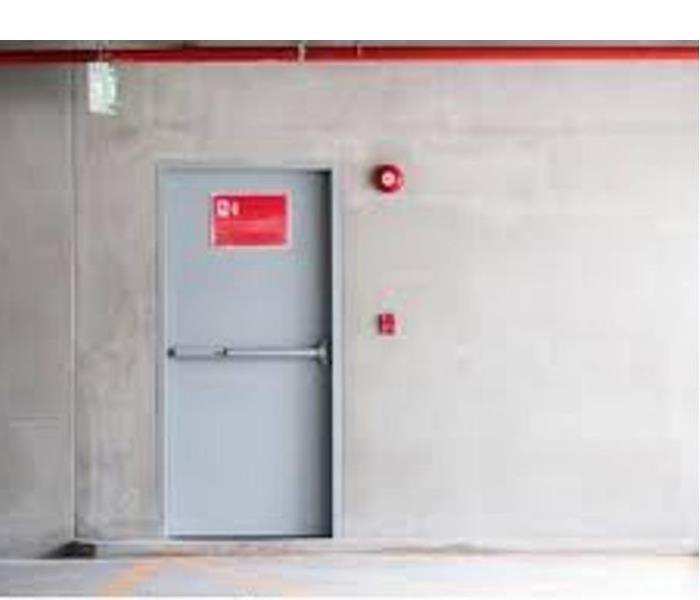Types of Fire Doors for Your Commercial Business
5/3/2022 (Permalink)
In the case of a fire, fire doors are necessary. They can buy valuable time, allowing residents to safely flee a structure. In the event of an emergency, they are critical not only for providing a clear and secure escape route but also for reducing the spread of flames and smoke. Because fire doors have the potential to save lives and reduce long-term damage, they must adhere to the building's strict health and safety rules.
The effectiveness of a fire door, as well as the type required, are determined by its location in the building and the types of fire dangers it faces. There are many various types of fire doors, ranging from different materials to different fire ratings and levels of protection.
Fire doors made of glass
It's hard to think that glass is a fire-resistant material, yet thanks to sophisticated fire technology, it's just as excellent as any other. It's crucial to understand that glass fire doors must be built of fire-resistant glass. This indicates that the glass has undergone the necessary fire testing and has been certified as fire-resistant.
The E certification denotes that the fire door glazing will remain transparent when exposed to fire or heat, allowing for maximum visibility and light transmission. It also implies that the glass will only impede the spread of fire and smoke, but not heat transmission. The number following the E classification grade indicates how long it will take for fire-rated glass to properly segregate regions and prevent fire and smoke from spreading.
Toughened fire glass can resist temperatures of over 1600°F, whilst normal glazing can only withstand temperatures of 250°F. Glass fire screens, and doors can also provide up to 120 minutes of fire protection. Following are the classes and classification of glass fire rated doors and screens :
- Class E: This is the most basic form of fire-resistant glass available. It can contain flames and smoke for a long period, but it can't stop heat from radiating from the source from being transmitted or transferred.
- Class EW: This is the second type of fire-resistant glass that can effectively contain flames and smoke for an extended period. It does, however, provide some insulation or resistance to the heat radiating from the source.
- Class EI: This is likely the benchmark in terms of fire-resistant glass, as it provides a broad range of protection. It protects individuals not only from fire and smoke but also from the heat radiated by the fire source.
- Fire doors E30: A glass door or screen with an E30 rating can defend against the spread of smoke and flames for 30 minutes in the case of a fire, providing a half-hour opportunity for anyone in the building to locate a safe escape path.
- Fire doors E60: E60 is a higher grade for glass fire screens and doors, indicating that it can endure heat and smoke for 60 minutes without losing its integrity and stability.
- Fire doors E120: The highest-rated fire-resistant glass is given an E120 rating, indicating that it can withstand the pressure of fire and smoke for up to 120 minutes before losing its effectiveness.
Fire doors made of wood
The British Woodworking Federation assigns an FD rating to timber fire doors to indicate their level of protection. Another prominent organization that supplies fire door ratings is the British Woodworking Federation (BWF). The BWF fire ratings for fire door assemblies are expressed in minutes and preceded by the initials FD: for example, FD30 stands for a 30-minute fire door or fire door set, which means it provides at least 30 minutes of fire protection.
The following are the most regularly used integrity levels:
- FD30 is for 30 minutes,
- FD60 is for 60 minutes,
- FD90 is for 90 minutes, and
- FD120 is for 120 minutes.
The current FD20 rating is no longer available as part of the BWF's efforts to simplify fire door identification and avoid specification misunderstanding.
Certified Fire Doors
Fire door sets can be certified by manufacturers for recognition and to ensure their functionality in a fire situation. The manufacturer's initial step is to build a fire door set to a specification that, in their opinion, will withstand a fire for a defined period.
BWF has its Certified Fire Door Scheme, in which they collaborate with FIRAS installers to ensure that the doors are installed according to their specifications. All fire doors that have completed the British Woodworking Federation's tests will be granted a BWF-CERTIFICATE, which will state the door's rating and ensure that it has been properly tested and is safe to use.





 24/7 Emergency Service
24/7 Emergency Service
